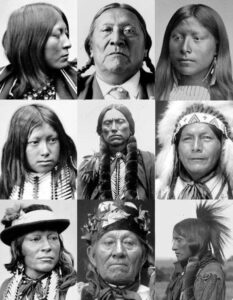Rose B Simpson
#NativeAmericanHeritageDay
November 26, 2021“Native Americans are the keepers of traditions and defenders of our natural resources. This Native American Heritage Day, I honor our culture and our ancestors. At the Interior, we will continue to include Indigenous knowledge as we protect our lands for future generations.”
-Secretary Deb Haaland, 54th Secretary of the Interior, 35th generation New Mexican, Pueblo of Laguna Tribe
[Image: Lakota Man/Twitter]
‘That’s what gods do, they spin threads of ruin through the fabric of our lives, all to make songs for generations to come.’ -Anthony Doerr ‘Cloud Cuckoo Land’, p.439
Post
C
o
l
o
n
i
a
l
Stress
D
i
s
o
r
d
e
r
PCSD
“We’re still in the genocide. It’s still happening; we’re still doing it.”
Why?
We need to look at our “individual power in relation to the world.” -Rose
Rilke: “…blessed our those who stood quietly in the rain. Theirs shall be the harvest; for them the fruits. They will outlast pomp and power, whose meaning and structures will crumble. When all else is exhausted and bled of purpose, they will lift their hands, they have survived.”
Mixed-media artist Rose B. Simpson lives and works from her home at Santa Clara Pueblo in New Mexico.
(This piece was commissioned for the the Conspire conference, Center for Action and Contemplation, in New Mexico.)
https://www.rosebsimpson.com/about
[Rose B. Simpson, Holding it Together (detail), 2016, sculpture]
Mitákuye Oyás’iŋ
All our relations
The Last Archive
Jill Lepore, historian and Harvard professor
“Indigenous paradigm, a paradigm about relationships–all things are kin, rocks the skies, trees, family…”
https://podcasts.apple.com/us/podcast/the-last-archive/id1506207997?i=1000540005084
LATIMES
“The Indigenous Serrano Language Was All But Gone, This Man is Resurrecting It.”
When Ernest Siva was a boy on the Morongo Reservation in Riverside County, he listened to the music and stories of his ancestors, who had lived in Southern California long before the land was called by that name.
He recalls running around a ceremonial fire on the reservation at age 5 as a weeklong ceremony honoring those who had died the previous year culminated with the burning of images in their likeness. Dollar bills and coins were thrown into the fire in tribute as tribal elders sang songs reserved for special occasions. Siva and his cousin chased after the singed money that fluttered out of the flames, largely ignoring the traditional lyrics in the background.
The specific words and rhythms are now distant memories for the 84-year-old Siva, a Cahuilla/Serrano Native American.
Siva is working to change that. For the last 25 years, the Banning resident has been a tribal historian with the Morongo Band of Mission Indians.
CIVIL EATS
In the face of climate change and persistent droughts, a growing number of people from Zuni Pueblo in New Mexico and elsewhere are adopting the traditional farming practice.
Historic Zuni waffle gardens, circa 1919. (Photo courtesy of Kirk Bemis)
“It’s going to be difficult, but in the meantime, we still have to do what we can to find ways to adapt and live with it. And I think that the waffle gardens are one tool for us to make it through.”
(The) hope is for every household within the Zuni village to have a backyard garden, and that such a shift could cut a family’s need to shop for groceries in half.
“A small, 4-by-8 [foot] garden will get you a good four to five buckets full of corn, which is not enough to completely live off, but enough to feed our families, survive, and carry out our traditions.” He also thinks it’s important for the Zuni people to lessen dependence on grocery stores, which the pandemic showed are vulnerable to supply chain disruptions.
The Resurgence of Waffle Gardens Is Helping Indigenous Farmers Grow Food with Less Water
Maria Popova
The Marginalian
“Ever since we climbed down from the trees, we have been looking up to them to understand ourselves and our place in the universe. “Nothing is holier, nothing is more exemplary than a beautiful, strong tree,” Hermann Hesse wrote a century ago in his sublime sylvan love letter, affirming that “when we have learned how to listen to trees, then the brevity and the quickness and the childlike hastiness of our thoughts achieve an incomparable joy.”
Centuries, millennia before Hesse — before Wangari Maathai won the Nobel Prize for her courageously enacted conviction that “a tree is a little bit of the future,” before scientists uncovered the astonishing language of trees, before Western artists saw in tree silhouettes a Rorschach test for what we are — the indigenous artists and storytellers of the Gond tribe in central India have been reverencing the secret lives of trees as portals into the inner life of nature, into the wildness of our own nature, into a supra-natural universe of myth and magic.”
The Secret Life of Trees: Stunning Sylvan Drawings by Indigenous Artists Based on Indian Mythology
R A I N
November 14, 2021Dear Beloved,
In the midst of my pain, give me comfort.
In the midst of my sorrow, give me peace.
In the midst of my brokenness, give me wings.
For You are the author of miracles
and I need one now.
We are spirit and thus we are more than the world.
-Marianne Williamson
Center for Action and Contemplation, New Mexico
Cultivating Radical Compassion
Author Tara Brach is a skilled psychotherapist and meditation teacher who has developed countless ways to help her students transform their suffering not only for their own sake but on behalf of the world. Over the last seventeen years she has focused particularly on the RAIN meditation practice, [1] which “cultivates a trust in our own basic goodness and by extension helps us recognize and trust that same light shining through all beings.” Brach suggests:
When you are caught in difficult emotions, the RAIN meditation can bring you back to a wise and compassionate presence. Give yourself a few moments to pause and turn inward.
R Recognize what is happening. Mentally whisper whatever you are aware of: fear, anger, hurt, shame.
A Allow. Let whatever you are feeling be here, without judging it, trying to fix it, or ignoring it. Simply pause and “let be.” You might whisper “This too belongs.”
I Investigate. With curiosity, feel into your body—your throat, chest, belly. Discover where the emotions live inside you. You might gently place a hand wherever feelings are strongest. Sense what is needed or being asked for right now. Is it love? Forgiveness? Acceptance? Understanding?
N Nurture. Offer care to feelings of vulnerability, hurt, or fear. Let the touch of your hand be tender, and send whatever message might most offer healing. You can imagine this coming from your own awake heart or from another being (friend, grandparent, spiritual figure, dog) you trust and love.
After the RAIN: Take some moments in stillness, simply sensing the quality of presence that has unfolded. Notice the shift from when you started (an angry or fearful or victimized self) to the compassionate awareness that is always here.
[1] To learn more about the RAIN meditation, see Tara Brach’s book Radical Compassion: Learning to Love Yourself and Your World with the Practice of RAIN (Viking: 2019). For online RAIN resources, visit tarabrach.com/RAIN.
Image Inspiration: This piece is of a series of reclamation and it’s about finding our identities and our empowerment in our histories and stories and timelines and how do we apply that to our beings in order to become whole.
Image credit: Rose B. Simpson, Reclamation II (detail), 2018, sculpture.
“The Center for Action and Contemplation featured the artist of these sculptures, Rose B. Simpson, at our recent CONSPIRE conference—so many of us were impacted by her creations that we decided to share her work with our Daily Meditations community for the month of November.”
—Rose B. Simpson, CONSPIRE Interview, 2021






